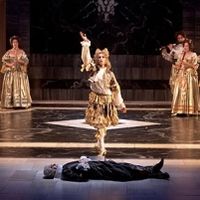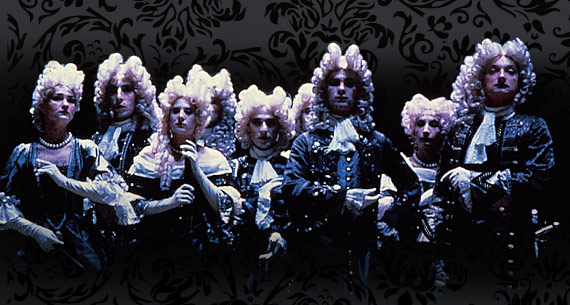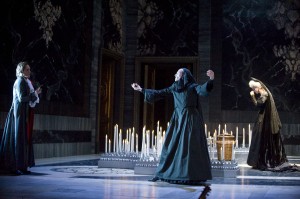The recent production of Lully’s Atys at the Brooklyn Academy of Music in New York City (September 18-24, 2011) has been remounted from the 1986 co-production of William Chrystie’s Les Arts Florissants and Francine Lancelot’s historical dance company Ris et danseries in collaboration with the director Jean-Marie Villégier. Atys burst on the scene (Florence, Paris, New York) at the height of the baroque revival in music and dance of the 1980s. Baroque specialist Philippe Beaussant called it “a sort of miracle” in his entry on the opera for the Encyclopaedia Universalis (1988). Atys first came to New York in 1989 with a return engagement in 1992 when it appeared to be the apogee of what was possible in the evocation of seventeenth-century tragédie lyrique, the operatic form most associated with the reign of Louis XIV. Rather than further stimulate the baroque music and dance revival of the eighties, it may have actually stalled it. The lavishness of the production values simply could not be matched by other productions of this repertory.

Clearly it would be hard to top this production’s budget, which was able to give us a seventeenth-century spectacle as only heretofore imagined. The patron who financed this revival, Ronald P. Stanton, said the first Atys had changed his life and he wanted to see it once more before he died. Originally produced by a king, only a millionaire can now produce Atys. This revival stands out among all baroque revivals as the most opulent, and therefore closest to the kind of spectacle of which it is an example. Atys has aged well. The concept has even been refined by the production team and comes across now with greater clarity than it did twenty years ago. Or, possibly, we are just better positioned now to understand it. Whatever the case may be, awareness of time passing lies at the core of this production as a concept and constitutes what one might call its effective baroque machinery.
With a dramatic libretto by Philippe Quinault and music composed by Jean-Baptiste Lully in 1676 Atys tells the story of a love quadrangle. The hero Atys is in love with Sangaride who is betrothed to his best friend, King Celenus. The goddess Cybèle is in love with Atys and reveals her love to him in a dream, which is the occasion for a remarkable choreographic interlude. Atys is a variant of Adonis who also refused to requite the love of a goddess, and was thus condemned to die (Atys kills himself). The sorrowful Cybèle turns Atys into a pine tree to commemorate her lost love. The drama is Cornelian in its geometrical symmetries and Racinian in its exploration of restrained but corroding passion. The severity of neoclassical tragedy is expanded out into operatic form. That is to say it adds excesses to the formal quality of French tragedy, but also illuminates French tragedy through those very excesses that are foreign to it. In this way, Atys becomes baroque for us today: an irregular pearl of immense beauty and poignancy that fits nowhere but draws on multiple traditions within the French seventeenth century.

The technique of recitative with basso continuo tells a story while maintaining the musical interest. The vocabulary of la belle danse, so unlike classical ballet and closer to court reality, is integrated with the narrative. This research into historical performance practices conjoined with the brilliant direction of Villégier is the artistic bedrock upon which the production relies. There are some noticeable differences from the earlier production. For one thing, Francine Lancelot is no longer with us (she died in 2003). The dances are reconstructions of the original choreography by her former assistant Beatrice Massin with her Compagnie Fêtes Galantes. Lancelot’s dancers gave us a weight and timing that seemed much closer to an earlier period, which contributed a layer of theatrical gravity that is missing in the more energetic and muscled style of Massin’s company. The star turn of Jean-Christophe Paré in his magical solo as Morphé is not reproducible by anyone. And, all the singers are new. Yet, the interview with Chrystie and Villégier and their individual essays published in the May 2011 Paris program testify to a maturation of the concept that is reflected on stage.
Despite the baroque quality of its profusion the production feels more unified and more powerful now than it did twenty years ago. Atys is made up of many potentially disparate elements that seemed in 1989 to be competing for precedence, but which now appear to be integrated into a larger concept. Despite the contribution of musical and choreographic expertise the production succeeds as spectacle. And, for this reason, music critics cannot really convey why this work succeeds the way it does. The sumptuous costumes, the large number of singers on stage, and the postmodern touches (the absence of furniture, a row of heads at the top of a backdrop, severe black, white and silver palette) as well as Lancelot’s choreography that takes off from the sources to add further layers of expressionism as performed by professional dancers, all make Atys powerful without seeming anachronistic.

The entire action transpires in one room at Versailles, which set designer Carlo Tommasi has even provided with a ceiling. The drama of characters entering and exiting through doors rather than coming on and off stage from the wings underlines the unity of place associated with French classical tragedy. Villégier has spoken of the king and his entourage gathering in the royal apartments to listen to excerpts of Lully operas in concert version. This was the director’s point of departure in setting the work at Versailles twenty years after the historical performance of Atys had taken place. The king had already stopped dancing and the court was shrouded in a mood of morose asceticism. The dream scene is a visualization of what the court might have imagined as the earlier performance of Atys in happier times.
The story thus unfolds as a ritual of memory in which the dream dispatched to Atys by Cybèle takes place in a golden aura of light while the surrounding opera is in somber black with glints of silver that complement the lush curls of white wigs. The dream is the nostalgia of the court for youth in the heyday of its earlier enthusiasm for court ballet. The present is cold and nocturnal whereas the dream rediscovers the light of day. This wonderful baroque conceit offers a model for our relation to the performance itself, which is bathed its own past as well as in ours. Our relation to this production is conditioned in more ways than one by the past: the 1980s compared to today; the 1650s compared to the 1670s.
Lancelot’s choreography should be acknowledged. Although based on historical reconstruction, it makes some successfully daring departures from conventional historical vocabulary. Atys may have given us some of Lancelot’s best choreography. It ventures into expressionistic areas that, by the end, mirror the mood of the drama itself. I am thinking in particular of the final scene of mourning in which the dancers remodeled baroque steps and gestures, almost pulling them out and blowing them up to a heightened level of suspension, sustained pause, and tension. This theatricalizes them and burns them into our memory. For the first time, the dancers are in black, shedding their role as divertissement and entering into the thick of the drama. It is a striking moment in which dance, music and narrative mesh to highlight the properly spectacular quality of baroque performance. Now, almost twenty years after the premiere in a very changed world, this production allows us to take a second look at our own conception of the baroque and the postmodern since the eighties.
For anyone wanting to recapture the original version, filmmaker Jacques Rozier recently revealed at a Paris screening that he had done a multi-camera shoot of Atys during a 1986 performance at the Montpellier Opera. I attended a screening of a rough cut last June at the Action Christine in Paris. Rozier is seeking the funding to do the final edit that will restore the first Atys. The film promises to be brilliant because it will not only capture the beauty of the original performance but will also view it from every possible angle in the cavernous Montpellier Opera house. It shows us performers backstage, the feats of the stagehands, and the crazy baroque impracticality of the theatre, as well as the style of the original.
Thank you for such an insightful article. I could not agree more with the statement that the production feels more unified and powerful than twenty years ago. We are all grateful for the revival!